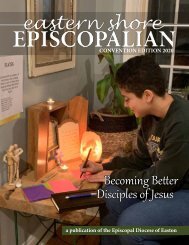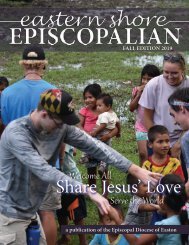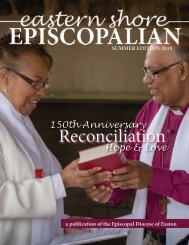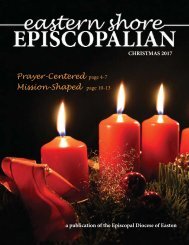Eastern Shore Episcopalian (ESE) - Convention 2018
- No tags were found...
Create successful ePaper yourself
Turn your PDF publications into a flip-book with our unique Google optimized e-Paper software.
8<br />
FAQs about Vocational Deacons<br />
in the Diocese of Easton<br />
By the Rev. Daniel Dunlap, PhD<br />
On behalf of the Commission on Ministry<br />
What are deacons?<br />
From the earliest days of the church, the order of<br />
deacons (or diaconate) has been recognized as one<br />
of three distinct orders of ordained ministry, along<br />
with bishops and presbyters (i.e. priests). The Book<br />
of Common Prayer describes deacons as called to a<br />
“special ministry of servanthood,” directly under the<br />
authority of the bishop. The word “deacon” comes<br />
from the Greek word diakonos, which means “servant.”<br />
A related word diakonia (servant ministry) is often<br />
used to describe the ministry of deacons. Yet the New<br />
Testament also uses diakonia to describe the ministry of<br />
all disciples.<br />
What is the role of a deacon?<br />
Deacons are called to serve all people but particularly<br />
“the poor, the weak, the sick, and the lonely.” Deacons<br />
are given the special task of interpreting to the Church<br />
the “needs, concerns and hopes of the world.” In this<br />
way the diaconate is a “bridge” between the church and<br />
the world, and the world and the church. Deacons are<br />
called to image Christ, “who came not to be served but<br />
to serve,” and to share in his ministry (cf. BCP, pp. 543,<br />
545).<br />
Where did deacons come from?<br />
Early church leaders, like Irenaeus (d. AD 202),<br />
believed that Acts 6:1-7 described the commissioning<br />
of the first deacons. This passage tells the story of a<br />
complaint brought to the twelve apostles in Jerusalem.<br />
Some widows (of a Hellenic or Greek background)<br />
were being overlooked in the daily distribution of food,<br />
while other widows (of Aramaic background) were<br />
being favored. As there was no social “safety net” at<br />
that time, the poor and the vulnerable (often widows<br />
and orphans) relied on the charity of the community to<br />
survive. To resolve this controversy the twelve proposed<br />
that the disciples choose from among themselves seven<br />
individuals “full of the Spirit and wisdom” (v. 3), to<br />
whom the ministry (diakonia) of waiting tables could<br />
be delegated, thereby allowing the apostles to continue<br />
to devote themselves to prayer and to the ministry<br />
(diakonia) of the Word. The apostles then prayed and<br />
laid their hands over the seven, ordaining them as the<br />
first deacons.<br />
How did deacons function in the early centuries of<br />
the church?<br />
The period of the second through the sixth centuries<br />
AD is often called the “golden age of deacons.” This<br />
was a time when deacons were often given more<br />
prominent and visible roles than presbyters. Deacons<br />
served as assistants or secretaries to bishops, provincial<br />
administrators, and even as episcopal envoys. The<br />
office of “archdeacon” was created during this period,<br />
denoting the most senior clerics of a province. It was<br />
even common for new bishops to be elected from<br />
their ranks rather than from among the presbyters.<br />
Nevertheless the primary role of deacons remained as<br />
it was in New Testament times: the distribution of alms<br />
to the poor and the care of the destitute. Thus Deacons<br />
also ran hospitals, hostels, and houses of refuge.<br />
Why are candidates for the priesthood ordained as<br />
deacons first?<br />
The practice of ordaining candidates as deacons prior to<br />
their ordination as priests arose in the early middle ages<br />
when ministry was viewed more or less as a ceremonial<br />
ascent up the ranks of the five minor orders (porter,<br />
lector, exorcist, acolyte, subdeacon) to the sacramental<br />
or holy orders of deacon, priest, and bishop. When the<br />
Church of England abolished the minor orders in the<br />
sixteenth century the order of ascent was drastically<br />
abridged, yet not completely eliminated. Candidates<br />
still entered holy orders through the “doorway of the<br />
diaconate.” However, the English Church also redefined<br />
the diaconate as a transitional apprenticeship prior<br />
to ordination as a priest. The 1550 ordinal required<br />
deacons to continue in office for “the space of a whole<br />
year at the least…to the intent that [he] may be perfect,<br />
and well expert in the things appertaining to the<br />
Ecclesiastical administration.” Today we call this the<br />
“transitional diaconate.”<br />
How does a vocational deacon differ from a<br />
transitional deacon?<br />
Transitional deacons are called to the priesthood, and<br />
have every expectation of being ordained priests after<br />
their formation as deacons is complete. For them the<br />
diaconate is another step in their formation. Vocational<br />
deacons are called to serve perpetually as deacons. They<br />
understand their “special ministry of servanthood” as<br />
an end in itself.









